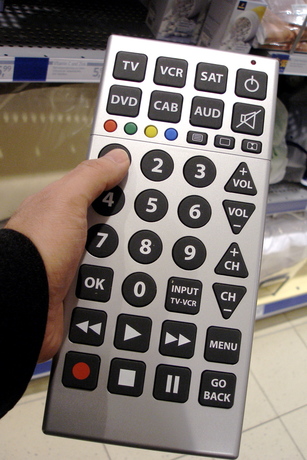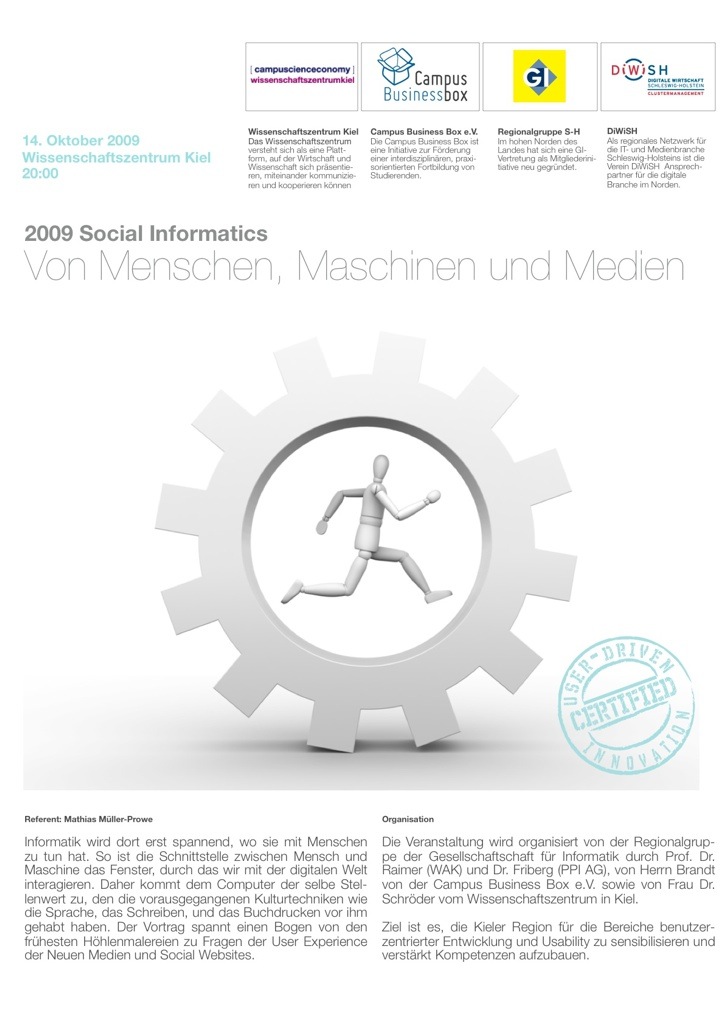 Powerpoint. Macht und Einfluss eines Präsentationsprogramms. Herausgegeben von Claus Pias und Wolfgang Coy im Fischer Verlag, 2009
Powerpoint. Macht und Einfluss eines Präsentationsprogramms. Herausgegeben von Claus Pias und Wolfgang Coy im Fischer Verlag, 2009
Author: mprove
Social Informatics. Vortrag in Kiel am 14.10.09
Zukunft braucht Herkunft – Weizenbaum. Rebel At Work. am 21.9. in Berlin

>>> Fwd >>>
Der Dokumentarfilm »Weizenbaum. Rebel at Work« wird auf der 13. GI-Fachtagung »Informatik und Schule – INFOS 2009« an der Freien Universität Berlin aufgeführt. Gezeigt wird der Film an der FU am 21. September 2009 um 18:00 Uhr im Hörsaal 1a der Rost-/Silberlaube, Habelschwerdter Allee 45, Berlin-Dahlem; im Anschluss findet eine Diskussion mit den Filmemachern statt. Der Film gehört zur Eröffnung der Konferenz, die ihr 25-jähriges Bestehen in Berlin begeht. Und er passt zum diesjährigen Motto: Zukunft braucht Herkunft.
Der 80-minütige Dokumentarfilm von Silvia Holzinger und Peter Haas porträtiert den deutsch-amerikanischen Informatikpionier und Gesellschaftskritiker Joseph Weizenbaum. In Berlin geboren, verließ Joseph Weizenbaum Deutschland 1936 und kehrte nach über 60 Jahren dorthin zurück. Der Film ist zugleich die erzählte persönliche Lebensreise des 85-jährigen „Rebellen“ und die Geschichte einer Jahrhunderterfindung, die des Computers.
“Der Film eröffnet gleichsam unsere Konferenz, die ihr 25-jähriges Bestehen in Berlin begeht. Er passt zum diesjährigen Motto: Zukunft braucht Herkunft” sagt Bernhard Koerber, Leiter der Tagung vom Fachbereich Erziehungswissenschaften und Psychologie, der die Filmemacher an die Freie Universität Berlin eingeladen hat.
Von Joseph Weizenbaum heißt es, er habe das Geschichtenerzählen in die Wissenschaft zurückgebracht. Im Film erzählt der alte Herr, der unter Informatikern zur Kultfigur geworden ist, sein Leben in Anekdoten und Exkursen. Er berichtet, wie er zum Professor am renommierten Massachusetts Institute of Technology ernannt wurde und wie es zu »ELIZA« kam, seinem wohl bekanntesten Beitrag auf dem Gebiet der Informatik. Der Zuschauer erfährt auch sehr Persönliches über den Gesellschaftskritiker und nimmermüden Mahner.
»Wir durften unseren Film bislang an mehr als 40 Orten präsentieren. Mit unserem Digitalen Kino in der Hochschule knüpfen wir an eine alte Tradition an und verstehen uns als Kulturbrücke zwischen Wissenschaft und Gesellschaft! Der Film hat seinen Weg in unzählige Schulen, Hochschulen und Medienzentren gefunden«, so Silvia Holzinger und Peter Haas, die für den unabhängig produzierten Film 2007 den Wolfgang von Kempelen Preis für Informatikgeschichte erhielten.
Die Veranstaltung findet bei freiem Eintritt statt, und ausdrücklich lädt die Freie Universität auch interessierte Zuschauer ein, die nicht an der Tagung teilnehmen.
Die Website zum Film bietet viele zusätzliche Materialen zum Download: www.ilmarefilm.org.
Weitere Informationen
<<<<
mehr auf mprove
Remote TV A11Y
This article is about reducing complexity with a knife, scissors, and some tape. These tools already indicate that I am talking about real life! Well, in fact you can cut all the wires of your power adaptors to simplify your life, but I do not recommending this right now. The problem at hand is a TV remote — I can hear your aarghs! Too many remote controls with too many functions, too tiny buttons, too easy to get lost, confusing labels and to sum it up: not suited to the task. My user population is an 80-yrs old lady with a telly hooked up to the cable; no special equipment like VCR, DVD, AUX 1-3 or SAT. Not to mention HD recorders, or TiVO with timeshift functionality. In my opinion it is even difficult for an educated engineer to use any remote control properly, but at 80 years you come from a totally different background to say the least, and your mental abilities are no longer at 100%. Usage errors are frequent — and the concept of Undo or Home is not available.
As said, my approach reduces the likelihood of user errors by making dangerous actions impossible to trigger:

http://www.23hq.com/mprove/photo/4903842
I find my design also superior to the competition because in terms of robustness you cannot remove the paper shield by accident.
 (also http://om.ly/Ipvj)
(also http://om.ly/Ipvj)
Other special remote controls aim to address a limited eyesight of the user by making everything larger:

http://www.23hq.com/mprove/photo/4903784
They shouldn’t have stopped here. Clear wording is preferred. But this is no news if you are familiar with accessibility guidelines. On the other hand, this is the first remote that offers a function to call a taxi (CAB) — I call that a unique selling point!
I suppose different shapes of buttons would also be a good idea, because haptic feedback becomes more important if you cannot see so well anymore; or if it’s quite dark in your living room with the home entertainment system. Though in the example above, channel and volume controls are too similar to get used to without taking a look all the time.
[originally published as a User Experience Forum Newsletter #28 | Join Xing]
service design is…

service design is interactive design meets industrial design meets advertising meets interior design meets graphic design meets sequential art. An interview with Pater Fossick by Paula Wallace.
/via Matthias Schrader
Design Process at Apple
Insights On Innovation. Apple thinks good design is a present. Pixel-perfect mockups are critical. 10 to 3 to 1. Paired design meetings. Brainstorm meeting. Production meeting. Pony meetings.
What else does Apple do differently? 1. Apple does not do market research. 2. Apple has a very small team who designs their major products. 3. Apple owns their entire system. 4. Apple focuses on a select group of products. 5. Apple has a maniacal focus on perfection.
So is it possible for you to innovate like Apple? You need a leader who prioritizes new product innovation. You need to focus. You need the right people, and you need to reward them.
Complete article at: You Can’t Innovate Like Apple — By Alain Breillatt
140 character bullshit
- @davewiner …with the user model. Again, this is engineering #bullshit. #reboot1111 minutes ago from web
- @davewiner …charachter limit. Dear software designers, please show a little respect for your users and do not confuse the system model…12 minutes ago from web
- @davewiner …tered tweets to maka them at least readable again. A similar UI could create a series of tweets if your reach the technical 140…13 minutes ago from web
- @davewiner …for your blurb. If the text gets longer twitter (or any UI that displays the tweets) could simply stitch together the scat…14 minutes ago from web
- @davewiner …the twitter medium. A low entry barrier is fine, though. And I also like that you do not have to artificially invent a title…19 minutes ago from web
- @davewiner …boundary that makes people feel stupid because they can not limit themselves to a reasonable amount of text that is accepted by…21 minutes ago from web
- @davewiner Indeed, the 140 chars limit is "bullshit" from the usabiltiy point of view. There is no technical reason te keep this hard…22 minutes ago from web
- RT @davewiner Steve Gillmor says 140 chars is plenty. I don’t have the nefarious motives he suggests, I just feel cramped… http://tr.im/pJaI23 minutes ago from web
Royal De Luxe
This is amazing. The largest puppets in the world.
Hijo de la luna Royal de Luxe by Volesprit76
Hijo de la luna Royal de Luxe
by Volesprit76
many more and a 1 hour documentary “La Visite du Sultan”.
Buxton meets Hustwit
Bill Buxton and Gary Hustwit – director of Objectified – met for a 17′ interview at mix09via http://visitmix.com/News/Buxton-Hustwit
sweet microblogging
When Peter approached me a few weeks ago to work on the UI design for the next release of Sweet, I had just started on twitter in order to understand what all the fuzz is about. Well, I cannot say I get it, but at least I got some interesting links that I had missed otherwise.
Now Sweet is our internal microblogging service, based on open source laconi.ca. You can try out laconica at identi.ca or take a look at the before state_
It is not possible to significantly change a project in mid air – but this is exactly what I did by tweaking the CSS and a few images to create a pleasant and inviting design for Sweet. Note the logo (done with creatr.cc), the color scheme, the layout, the text counter, the tabs, the font changes, and the tag cloud in the after image. BTW_ the bird in the tree indicates that a tweet is also visible to the public on twitter.
Paying attention to the ‘design details’ can even improve the usability of such a project. A professional design increases the perceived quality and therewith the user experience. Since the relaunch we have more users and we even figured out that there was another installation of laconica running inside Sun — they are now planing the migration to Sweet.
All this took me less than a week. I learned a lot about dirty CSS hacks, and got in touch with 2 nice colleagues at Sun whom I never met in person. Peter was a kind of project lead, and Olof the engineer behind the curtain. And guess what, our main communication tool was… Sweet!


